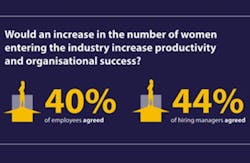Women Are Reluctant to Join Oil & Gas Workforce, Survey Shows
Findings from the latest oil & gas Global Workforce Survey, published jointly by OilCareers.com and Air Energi, reveal that efforts to encourage more women into the industry are not yet working. The results also highlight widespread confusion among the workforce as to whether or not internal initiatives are effective.
More than 4,300 employees and hiring managers working in the oil & gas industry took part in the survey that looked at the issues surrounding the lack of women taking on key roles in the sector.
In the Americas, 41 percent of respondents reported the industry gender imbalance as a concern, with 47 percent stating that the industry culture created by a male-dominated environment plays a key role in discouraging women from entering oil & gas jobs.
The survey also highlighted what action the workforce thinks should be taken to address the issue in the region. Forty-one percent reported that the industry should encourage more girls to study science, technology, engineering and mathematics (STEM) subjects, while 34 percent stated emphasis on progression and leadership opportunities would encourage more women into the industry.
SEE ALSO: Infographic: Gender Gap in the Oil & Gas Industry
"Given the chronic skills gap in oil and gas, the last 12-18 months has seen many companies waking up to the fact that there is a distinct lack of women joining the industry," OilCareers.com managing director Mark Guest said. "Encouraging girls to study STEM subjects at school is something that may impact the industry, but only in the future. There are many women around the world who already have related business, science or engineering degrees and still don’t consider oil and gas as a career option. This really needs to be addressed for the long-term good of the industry."
Responses, however, showed that there is an appetite to address the situation with 65 percent stating that tackling the imbalance would allow the industry access to a wider talent pool. Thirty-seven percent reported that it would increase overall productivity and organizational success across the Americas.
"Our findings show the masculine image and perception of the industry pervades in every region and this is a crucial barrier in the minds of many women," Air Energi CEO Duncan Gregson said. "By addressing this, along with improving the scope and measurement of internal company initiatives, it is possible that we will start [to] see a shift in the number of women coming into oil and gas at all levels of seniority. In short, someone in every company needs to be accountable for these initiatives and have the authority to adapt them if they need to."
Many companies have chosen to address the gender gap through recruitment quotas; however, not even half (44 percent) of hiring managers who knew their company had an active policy to encourage more women into oil & gas roles could say for sure whether or not this policy was effective.
"Where cultural practices allow, organizations cannot half-heartedly seek to recruit more women on the one hand, while at the same time complain of a chronic skills shortage on the other," Guest continued. "The industry has to take an all-encompassing view of the situation in order to ever successfully address it."
The survey also looked into overall hiring activity and salary expectations around the world. Forty-six percent of hiring managers thought recruitment levels for permanent staff will remain steady, and 48 percent thought recruitment of contract personnel would remain the same throughout the second part of 2014 compared to the first six months. The findings reflect a more cautious industry overall with fewer hiring managers (38 percent) expecting salary rates to continue to increase, compared to 58 percent in the workforce survey conducted in the first half of 2014.
These findings come as part of the second OilCareers.com and Air Energi global workforce survey of 2014. Views have been collated from industry professionals across Europe, Africa, the Middle East, the Americas, Asia-Pacific and Australasia.
The report also includes insight from organizations including Women in Science and Engineering (WISE) and Women’s Global Leadership Conference (WGLC).



